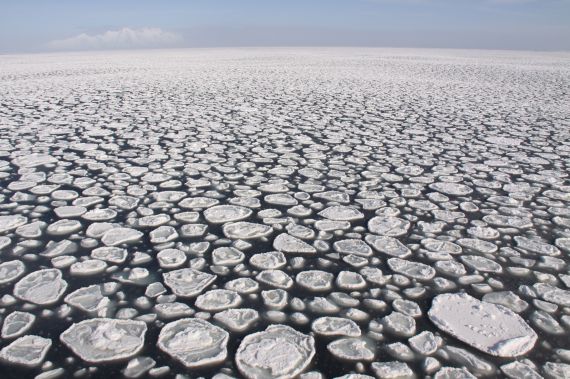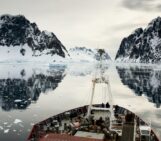The thought of pancake ice always makes me a little hungry – I just can’t help thinking about stacks of syrup-drowned pancakes, or crepes covered wish sugar and doused with lemon juice – but the science of pancake ice is quite a tempting topic too!
Pancake ice occurs in areas where ice formation is repeatedly disturbed by water movement. In the Southern Ocean, the water extremely open and the swell of the waves causes a large soupy mixture of saltwater and needle-like ice crystals (frazil) to form. This slushy mixture is known as grease ice. Cyclical movement of the slush causes crystals to be compressed and begin to form cakes. Over time, the ice crystals stick together to form thin pancakes that are roughly 30 centimetres to 3 metres in diameter, like these:

Pancake ice in Drake Passage, the Southern Ocean” by Kenneth Mankoff. This photo is distributed by the EGU under a Creative Commons licence.
This field of ice pancakes in the Southern Ocean is constantly moving as waves cause them to jostle and bump on the water’s surface. The bumping causes the soupy grease ice to be sloshed up onto the edges of each pancake. As the water drains away, a raised lip of ice crystals is left behind – the feature that gives pancake ice its wonderful pancake-like texture.
In the Northern Hemisphere, pancake ice may become more common as the decline in inter-annual sea ice cover frees up larger expanses of water and allows it to swell. Pancake ice isn’t exclusive to the oceans though – it can also form on rivers when temperatures are close to freezing point – enough to form ice crystals, but not so low that the whole river freezes over.
By Sara Mynott, EGU Communications Officer
References:
Linder, C. A.: Sea Ice Glossary. Woods Hole Oceanographic Institution, 2003 (accessed November 2013)
Wadhams, P.: How Does Arctic Sea Ice Form and Decay? NOAA, 2003 (accessed November 2013)
Wilkinson, J. P., DeCarolis, G. Ehlert, I et al.: Ice Tank Experiments Highlight Changes in Sea Ice Types, EOS Transactions, American Geophysical Union, 90, 81-82, 2009
The EGU’s open access geoscience image repository has a new and improved home at http://imaggeo.egu.eu! We’ve redesigned the website to give the database a more modern, image-based layout and have implemented a fully responsive page design. This means the new website adapts to the visitor’s screen size and looks good whether you’re using a smartphone, tablet or laptop.
Photos uploaded to Imaggeo are licensed under Creative Commons, meaning they can be used by scientists, the public, and even the press, provided the original author is credited. Further, you can now choose how you would like to licence your work. Users can also connect to Imaggeo through their social media accounts too! Find out more about the relaunch on the EGU website.




